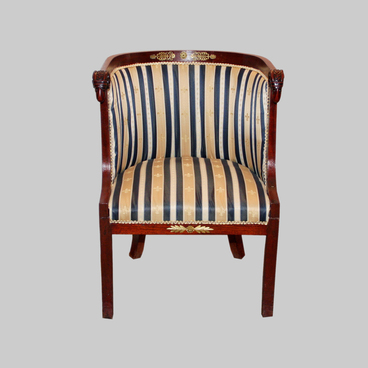Decembrist Matvey Ivanovich Muravyov-Appostol was in Yalutorovsk from 1836 to 1856. According to the recollections of his contemporaries, he lived in an elite part of the city, in a very well furnished house. The house was built much earlier, in 1795, and modern furniture was imported, which was created in the first half of the 19th century.
Today, the basis of the museum funds are collections of ancient copper casting, icons, numismatics, rare books, glassware. The museum also displays a collection of furniture from the 19th-20th centuries, a collection of paintings, sculptures, ceramics, metal and wood.
In the living room of the house of MatvEy Muravyov-Apostol there is a copy of Raphael SantI’s painting Madonna on a Chair, painted by an unknown artist in the first quarter of the 19th century. The painting was transferred to the museum in 1991 by the All-Russian Art Scientific and Restoration Center named after Academician I.E. Grabar.
Rafael SantI is a Renaissance painter. In 1513-1514, while living in Rome, Raphael painted one of his Madonnas, called Madonna Della Sedia or translated from Italian Madonna on a Chair. For many years this painting was exhibited at the Palazzo Patti in Florence. The master depicted in the painting the Virgin Mary embracing the infant Christ and in awe of the mission of the young John the Baptist. The image of the woman in the Madonna on a Chair is significantly different from the artist’s previous works. A feature of this picture is the novelty of the image so beloved by RaphaEl: the image of the Madonna is endowed with a certain vitality and earthly fascination. She is depicted as a loving, caring mother who quit her job as soon as she heard her first baby cry.
The unknown artist managed to subtly convey the atmosphere of Raphael’s painting. Bright, saturated clothing colors afford the image of Madonna some sophistication and at the same time help to create a down-to-earth look. It is known that Raphael was posed for by his beloved FornarIna, the daughter of Francesco Luti, a baker from Siena who worked in Rome. According to one version, her real name is MargarIta Luti. Raphael used the appearance of Margarita for many images of women on his canvases. Only in select ones of them strangers posed for him.
Today, the basis of the museum funds are collections of ancient copper casting, icons, numismatics, rare books, glassware. The museum also displays a collection of furniture from the 19th-20th centuries, a collection of paintings, sculptures, ceramics, metal and wood.
In the living room of the house of MatvEy Muravyov-Apostol there is a copy of Raphael SantI’s painting Madonna on a Chair, painted by an unknown artist in the first quarter of the 19th century. The painting was transferred to the museum in 1991 by the All-Russian Art Scientific and Restoration Center named after Academician I.E. Grabar.
Rafael SantI is a Renaissance painter. In 1513-1514, while living in Rome, Raphael painted one of his Madonnas, called Madonna Della Sedia or translated from Italian Madonna on a Chair. For many years this painting was exhibited at the Palazzo Patti in Florence. The master depicted in the painting the Virgin Mary embracing the infant Christ and in awe of the mission of the young John the Baptist. The image of the woman in the Madonna on a Chair is significantly different from the artist’s previous works. A feature of this picture is the novelty of the image so beloved by RaphaEl: the image of the Madonna is endowed with a certain vitality and earthly fascination. She is depicted as a loving, caring mother who quit her job as soon as she heard her first baby cry.
The unknown artist managed to subtly convey the atmosphere of Raphael’s painting. Bright, saturated clothing colors afford the image of Madonna some sophistication and at the same time help to create a down-to-earth look. It is known that Raphael was posed for by his beloved FornarIna, the daughter of Francesco Luti, a baker from Siena who worked in Rome. According to one version, her real name is MargarIta Luti. Raphael used the appearance of Margarita for many images of women on his canvases. Only in select ones of them strangers posed for him.


